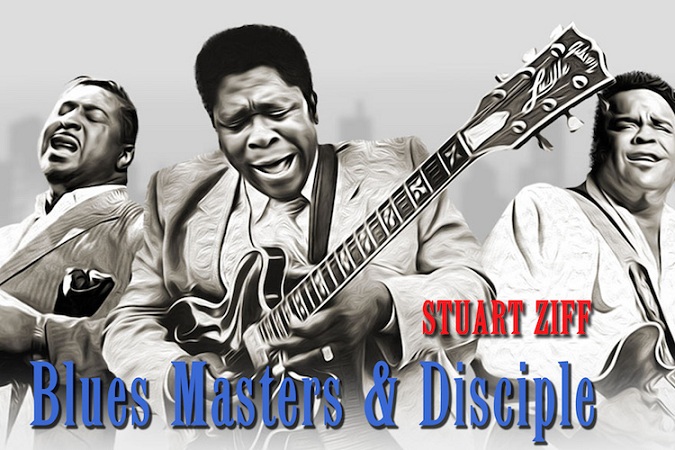时长8小时46分钟。更多预览
Lesson 1: Series Introduction
As guitarists, we all draw from what we know and like. And when we look closely at the greats, we learn to reflect their greatness in our own playing. Join Stuart as he introduces us to the Masters and their Disciples.
Lesson 2: Major and Minor Pentatonic Review
The foundations of blues soloing are the major and minor pentatonic scales. Before we get started looking at some of the blues greats, Stuart gives a quick review of all 5 patterns of the major and minor pentatonics.
Lesson 3: Drop 2 Arpeggios: Inversions 1 & 2
To have command of your fretboard and to improve your soloing, it's very important to know what makes up a chord - in other words, your arpeggios. Here, Stuart shows us a method for learning patterns 1 and 2 of your dominant 7th, drop two arpeggios.
Lesson 4: Drop 2 Arpeggios: Inversions 3 & 4
When learning the fretboard is your goal, arpeggios are a tried and true method. Stuart continues by showing us patterns 3 and 4 of the drop two arpeggios, along with a great way to practice them!
Lesson 5: T Bone Walker: The Father of Texas Blues
Now we get into the players. All electric blues guitar points back to T-Bone Walker. In this lesson, Stuart introduces us to some of the things that made him legendary: his sense of timing, rhythm and swing, and his use of space.
Lesson 6: Single Note Solos in the Style of T Bone Walker
T Bone Walker, the Father of Texas Blues crafted single note solos that were fluid and very horn-like. Stuart takes a look at this and other attributes that made him one of the original bridges between blues and jazz.
Lesson 7: Shuffle in the Style of T Bone Walker: Rhythm
Among other things, T Bone Walker was an authority in regards to rhythm playing. In this up-tempo shuffle, sometimes called a "jump blues", Stuart demonstrates how T Bone would punctuate the groove with horn section-like rhythm parts.
Lesson 8: Shuffle Feel Solo in the Style of T Bone Walker
Being that bridge between jazz and blues, T-Bone had lots of jazzy elements in his playing: not a lot of bending, use of the 9th and other ear grabbing chord tones. Stuart uses a simple, bluesy harmony over this shuffle feel to demonstrate these qualities.
Lesson 9: Swing Feel Rhythm in the Style of T Bone Walker
So how do you comp a rhythm part against an upbeat track? In this lesson, Stuart shows us how to execute a swing feel rhythm over this T-Bone style track based on the classic "Strolling with Bones".
Lesson 10: Walkin' Bones Head Melody
What is a head melody? Well, think of it as you would a chorus in a song being sung. Only in jazz, we refer to it as a "head melody". Learning this simple melody will get you into the feel of this track!
Lesson 11: Walkin' Bones Solo
We've learned the rhythm and the head melody, now Stuart shows us a call and response technique that he integrates into the solo, along with swung eighth notes and repetitive figures. Note the very horn-like phrasing that was a hallmark of T-Bone's style.
Lesson 12: Intro to B.B. King
His technique. His distinctive vibrato. His use of major and minor pentatonic scales. We're talking about the great B.B. King. Stuart gives us a worthy introduction to the first "King" and shows the connection to the past in T-Bone Walker.
Lesson 13: Shuffle in the Style of B.B. King
B.B.'s sweet sound could be boiled down to his note choices. The manner in which he combined the major pentatonic and minor pentatonic scales was the primary way in which he made the guitar speak. And make no mistake - the guitar was B.B.'s voice!
Lesson 14: B.B. the Boss Part 1
B.B. King had many classic moves that Stuart will now take a look at. He had a way of addressing the chords of a song, then applying his nuanced bends and signature vibrato to give us the legendary sound we know and love!
Lesson 15: B.B. the Boss Part 2
In part 2 of B.B. the Boss, Stuart asks us to forget about the "B.B. box" that everyone obsesses over, and focus in on the dynamics and emotion that made B.B. the king of the blues.
Lesson 16: BB's Big Thrill Part 1 - Rhythm Style
One of B.B.'s most iconic records has a rhythm guitar part played by the legendary Hugh McCracken. On this track in the style of "The Thrill is Gone", Stuart demonstrates how the rhythm guitar part can dictate the feel of a song.
Lesson 17: BB's Big Thrill Part 2 - Lead Style
Soloing over a minor blues can be a lot of what NOT to play, especially when emulating the tasteful style of B.B. King. Join Stuart as he talks about finding the right note combinations, where to bend, and what notes to stay away from.
Lesson 18: BB's Locked Door, Part 1 - Rhythm
Playing rhythm guitar over a slow blues can be one of the hardest things to get right when learning to master the blues. It requires a lot of restraint, and a single minded focus on supporting the groove.
Lesson 19: BB's Locked Door, Part 2 - Lead
No doubt about it, B.B. King was the master of the slow blues. His feel, emotion and note choice were impeccable. Using the classic call and response technique, Stuart emulates B.B.'s slow blues style on this classic sounding "in the style of" track.
Lesson 20: Intro to Albert King
Left Handed. Upside down. Radical string bending. Fingers and no pick. We're taking a look at Albert King now. Another unique, powerful voice in the world of blues, his bending in particular influenced the likes of Eric Clapton, Duane Allman and Stevie Ray Vaughn.
Lesson 21: Albert's Down and Out Part 1 - The Rhythm
When analyzing Albert King's style, we must take into account his work with the Stax Records rhythm section, in particular, Steve Cropper. Here, Stuart shows us how Cropper really opened up space in the song through his rhythm guitar part.
Lesson 22: Albert's Down and Out Part 2 - The Lead Style
Demonstrated in this lesson is Albert King's unique lead guitar style. His instantly recognizable playing was compiled of his phrasing, timing, string bending and overall attitude. Now you'll be able to grab bits and pieces of his phrases to compose your own solo!
Lesson 23: Draggin' That Saw, Part 1 - The Rhythm
Now Stuart looks at a blues staple in the New Orleans rhumba-style feel. A traditional Latin feel that was adapted to the blues, it is highlighted by contrasting differences in the rhythm section. This is all to understand the timing for soloing in the next lesson.
Lesson 24: Draggin' That Saw, Part 2 - The Lead
Strong groove and great phrasing highlight this Albert King style solo over the New Orleans rhumba feel. We'll take some of the timing and bending techniques that we learned in a previous lesson and apply it to this unique rhythmic feel.
Lesson 25: Albert Gets Personal Part 1 - The Rhythm
The Albert King slow blues - a feel that depends on timing and space. One of the hardest feels to master, Stuart uses the tremolo effect to help accentuate the space in the track, helping you to relax and take your time!
Lesson 26: Albert Gets Personal Part 2 - The Lead
In the slow blues, feel always trumps the number of notes. No one knew this better than Albert King. As Stuart guides you, be aware of the tempo and try to stay relaxed. The goal is to mimic the feel and eventually construct your own solo!
Lesson 27: Albert's Big Feet
A player's feel and rhythm can shift when the song shifts feel and style. We've looked at a shuffle, a rhumba and a slow blues in the style of Albert King. Now it's time to travel to Memphis and get greasy with this funky track!
Lesson 28: Intro to Freddie King: The Texas Cannonball
Are you hearing Clapton? Maybe Billy Gibbons? Well, they were both influenced by the Texas Cannonball. His distinctive playing included intense one and two bar phrases, and hanging on one note. Fierce, sweet and nasty are just a few words used to describe Freddie King.
Lesson 29: Wake Up Freddie Part 1 - Rhythm
Stuart now takes a look at the rhythm part of this track based on the classic, Woke Up This Morning. Syncopated eighth notes are the key to making this track groove. Add in the 9th chords, and you've got a very "jazzy" sounding blues track!
Lesson 30: Wake Up Freddie Part 2 - Soloing
Freddie King was known for his aggressive style of guitar playing, and his very distinctive tone that really cut through the mix. In this lesson, Stuart locks in on Freddie's lead style by being choosy about which notes to bend, and which phrases to repeat.
Lesson 31: Freddie's Slow Blues
This slow blues in the key of D encounters the challenge of playing at or around the 10th fret. Freddie was a master of being dynamic and grooving even when playing in a higher register on the guitar, just as Stuart tries to emulate here.
Lesson 32: Intro to Duane Allman
Now we get to one of the Disciples that was influenced by everyone we've looked at so far in this series: Duane Allman. One of the most influential players from late 60's and early 70's, Duane developed his own distinctive style with and without his slide.
Lesson 33: A Real Lover's Man
In listening to Duane Allman, you could tell that he had been listening to T-Bone, the Three Kings, Muddy Waters and so on. Taking all of these influences, he put together his own fluid, lyrical and conversational style that Stuart demonstrates in this lesson.
Lesson 34: Allman City Limits
Duane's bending of notes gave his playing a very animated quality, along with his sense of swing and phrasing that were unique to his playing. In this slow blues track, Stuart demonstrates some of the attributes that made Duane a powerful force in the blues world.
Lesson 35: Do You Love Me?
In some of the early Allman Brothers records, Duane's power was on full display. He had great facility when playing on slow blues, and up tempo songs as well. In this lesson, Stuart demonstrates many facets of Duane's playing on this upbeat number.
Lesson 36: Call Home
Along with being a phenomenal blues player, Duane was also adept at playing in the pop/rock, singer/songwriter style featured on some of the Allman Brothers records. On this track, Stuart demonstrates some of Duane's country-like taste that made him such a versatile player.
Lesson 37: Intro to Mike Bloomfield
Mike Bloomfield was a player with great speed and facility on the instrument that was ahead of his time. He left us way too soon after blazing a trail through the 60's and 70's influencing countless guitarists along the way, including Stuart Ziff.
Lesson 38: Shuffle for Mike
In this lesson, Stuart takes a look at Mike Bloomfield's style and how he used many of the techniques we've discussed so far in this series: using the major and minor pentatonics, addressing the chord changes and using arpeggios.
Lesson 39: Hello Mary
Bloomfield was a powerhouse blues talent. Even on a track like this one, with changing feels, Mike kept the intensity up at all times. In this lesson, Stuart emulates and analyzes some things Mike may have played over this type of track.
Lesson 40: Lone Star
In this lesson, Stuart takes on the daunting task of playing a slow blues, and playing with such intensity and aggression that it challenges ones timing and groove. Mike Bloomfield was a master at this, and it can be heard in many of his recordings.
1.如果遇到其他问题可到问答社区进行提问!“进入问答社区”
2.本站非常重视知识产权,如有侵犯任何第三方权益,请及时联系我们,将及时予与删除!“版权协议点此了解”!


 x
x